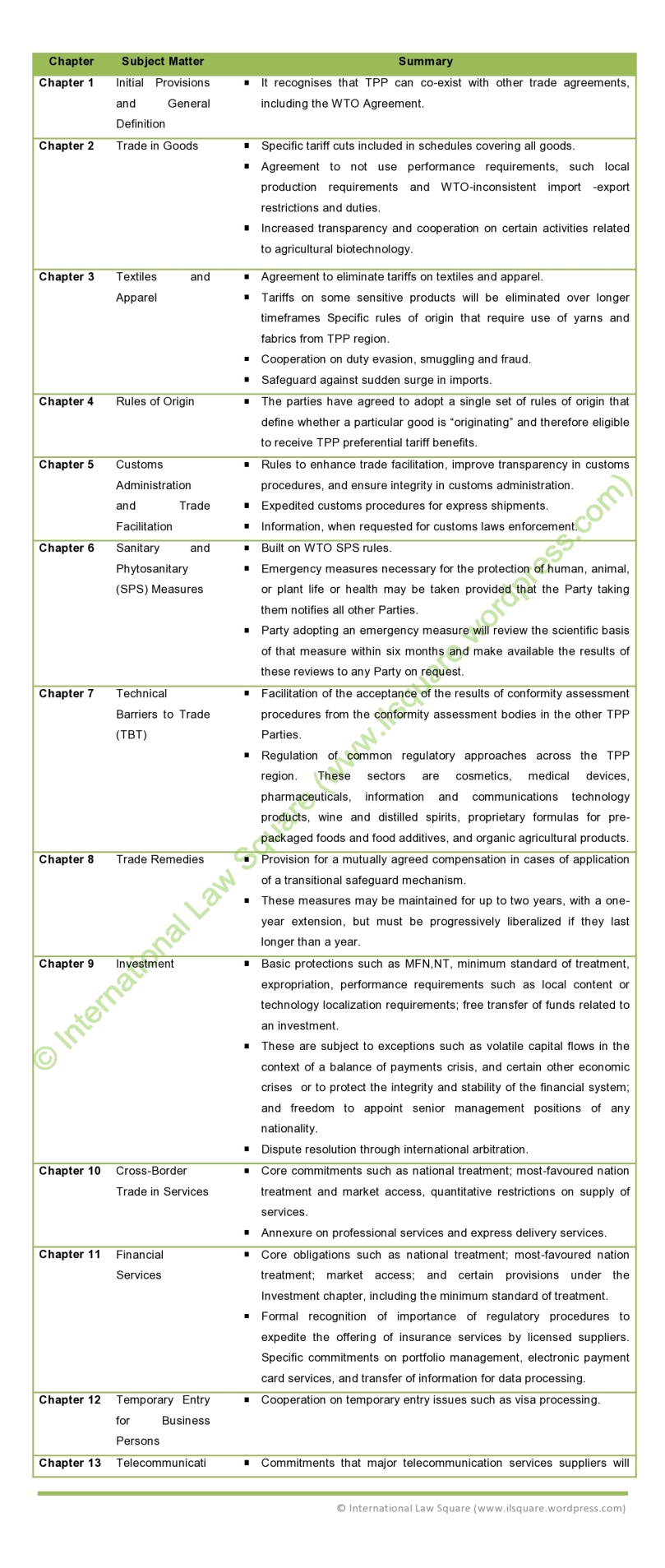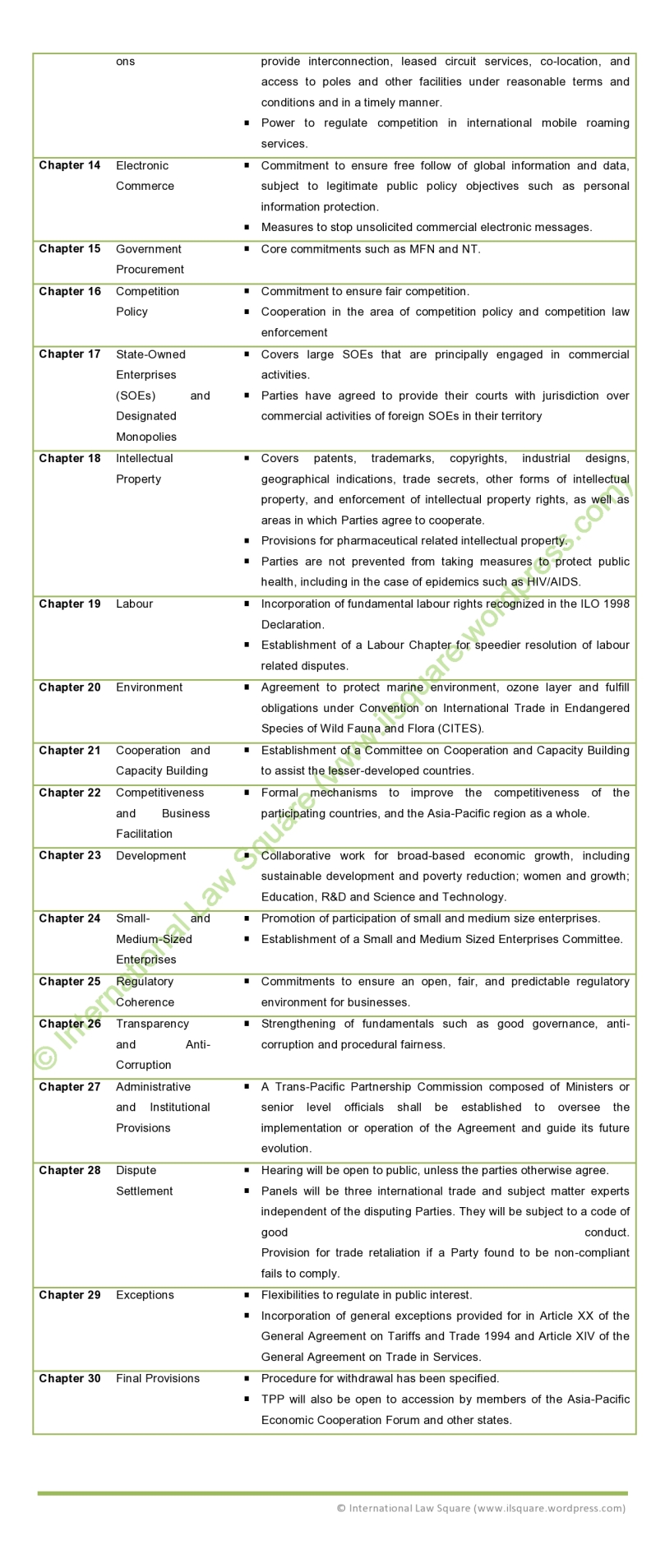By Sarthak Malhotra
The negotiations for the Trans Pacific Partnership Agreement (TPP), a mega Free Trade Agreement between Australia, Brunei Darussalam, Canada, Chile, Japan, Malaysia, Mexico, New Zealand, Peru, Singapore, United States, and Vietnam have concluded on 4th October, 2015.  Based on what the Governments are saying, this agreement will promote economic growth, create jobs, enhance productivity and competitiveness, reduce poverty and promote transparency & good governance.
Based on what the Governments are saying, this agreement will promote economic growth, create jobs, enhance productivity and competitiveness, reduce poverty and promote transparency & good governance.
The official text of the Agreement has not been released yet. However, USTR has released a summary of what the Agreement talks about. It can be accessed here.
Similar to what other FTAs do, the TPP aims to reduce tariff and non-tariff barriers across nearly all types of goods, services, trade and investment. It also includes commitments to help small and medium size enterprises to take advantage of the Agreement and build their trade capacity. The veracity of these assertions and claims remains to be proven till the official text is released.
The Agreement has 30 chapters covering trade in goods; customs and trade facilitation; sanitary and phytosanitary measures; technical barriers to trade; trade remedies; investment; services; electronic commerce; government procurement; intellectual property; labour; environment; development, competitiveness, and inclusiveness; dispute settlement, exceptions, and institutional provisions. Certain contemporary issues such as digital economy, role of state-owned enterprises have also been given a place in the Agreement.
The 12 members of TPP account for 40% of the total world trade and a population which is nearly double of the European Union. Many have regarded this Agreement to be a sister agreement to the Transatlantic Trade and Investment Partnership(TTIP) which is between the US and the EU.
Despite the criticism faced by Investment Arbitration around the world, the TPP has chosen Investment Arbitration as the preferred method for resolving disputes. This is certainly a blow to the TTIP negotiations in which establishment of an Investment Court is being negotiated. It is noteworthy that the TPP Agreement has also incorporated certain safeguards to ensure transparency and efficiency in dispute resolution. These include-
- opportunity for amicus curiae submissions;
- non-party interventions;
- binding joint interpretations by the TPP Parties;
- mechanism to address abusive or frivolous claims; and
- a review procedure for interim awards.
- Binding code of conduct for arbitrators
Following is a brief summary of what the TPP Text will look like:
(You can click on the images to open them in a new tab and zoom in.)
[EDIT 1:] The text has been released just now. You can access it here: http://tpp.mfat.govt.nz/text



Another win for ISDS!? You think just concluding negotiations is a win! How cute! It has been more than a month since your post! What big difference has TPP made?
The true test lies in ratification! The TPP comes into effect 60 days after the 12th TPP member completes its ratification of the deal.
As far as I know it hasn’t even been submitted to the US Congress for ratification yet. I foresee a long wait before TPP coming into force…
LikeLike
Hi WTO Lover !
Thank You for your comment.
“This is certainly a blow to the TTIP negotiations in which establishment of an Investment Court is being negotiated. It is noteworthy that the TPP Agreement has also incorporated certain safeguards to ensure transparency and efficiency in dispute resolution.”
You might know that EU has finalised and is currently advocating a proposal for investment Court System for TTIP. It is in this context that my statement should be construed.
Further, ‘win for ISDS’, as you put it and ‘win for investment arbitration’, as I have put it differ in their meaning. At a time when the community especially sovereigns are arguably not satisfied with the current investment arbitration regime and EU’s proposal, the fact that TPP decided to choose Investment Arbitration to resolve their disputes reaffirms Investment Arbitration’s strength. Hence, ‘Another win for investment arbitration’.
Its true that the real test lies in ratification but TPP’s dispute resolution regime shows that countries still prefer investment arbitration.
LikeLike